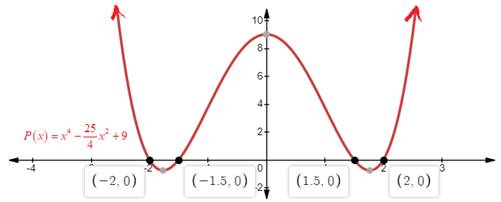
Concept explainers
To find : the rational zeros of the given function
Answer to Problem 103E
The rational zeros of the function are:
Explanation of Solution
Given information:
Concept Involved:
The zeros of the polynomial are the values of x where the graph cuts the x-axis and makes
Synthetic Division (for a Cubic Polynomial):To divide
| In case when we have a polynomial with a missing term, insert placeholders with zero coefficients for missing powers of the variable. Vertical pattern: Add terms in columns Diagonal pattern: Multiply results by k. This algorithm for synthetic division works only for divisors of the form x - k. Remember that |
The Division Algorithm: If
Calculation:
To find the zeros of the function set the polynomial equal to zero
To get rid of the fraction in the equation multiply 4 throughout the equation
Identify two numbers in such a way that their product (ac) is 144 and sum (b) is -25 by listing out the factor pairs of 144 and see which two add up to give -25.
Factor the GCF of first two terms and GCF of last two terms in left side of the equation
Factor the common binomial from left side of the equation
Rewrite the binomials inside each parenthesis
Use the algebraic identity
We need to set each factor equal to zero using the zero factor property which states that
“If
Solving the 1st equation
- By subtracting 2 on both sides
- By simplifying the equation on both sides
Solving the 2nd equation
- By adding 2 on both sides
- By simplifying the equation on both sides
Solving the 3rd equation
- By subtracting 3 on both sides, then
- By simplifying on both sides, then
- By dividing 2 on both sides, and then
- By simplifying fraction on both sides
Solving the 4thequation
- By adding 3 on both sides, then
- By simplifying on both sides, then
- By dividing 2 on both sides, and then
- By simplifying fraction on both sides
Graph:

Conclusion:
The rational zeros of the function are:
Chapter 2 Solutions
Precalculus with Limits
- Find an equation of the curve that passes through the point (0, 1) and whose slope at (x, y) is 3xy.arrow_forwardQ6. A fossil piece has been found in Alberta that contains 34% of C14 in it. What is the age of this fossil piece?arrow_forwardQ5. Briefly explain what are isotopes of an elements, with an example, and why some isotopes are radioactive. 470arrow_forward
- Q1. Will you earn more interest amount in two years by depositing $2000 in a simple interest account that pays 6% or in an account that pays 6.15% interest compounded monthly? tarrow_forwardQ4. We want to invest $18000 in an account compounded continuously. How long should the investment be kept so final value of the account reaches $25000 if the annual rate of interest is 5.8%?arrow_forwardQ3. Determine the effective annual yield for each investment below. Then select the better investment. Assume 365 days in a year. a) 5.6% compounded semiannually; b) 5.4% compounded daily.arrow_forward
- Q2. You deposit $22,000 in an account that pays 4.8% interest compounded monthly. a. Find the future value after six years. & b b. Determine the effective annual yield of this account.arrow_forward18. Using the method of variation of parameter, a particular solution to y′′ + 16y = 4 sec(4t) isyp(t) = u1(t) cos(4t) + u2(t) sin(4t). Then u2(t) is equal toA. 1 B. t C. ln | sin 4t| D. ln | cos 4t| E. sec(4t)arrow_forwardQuestion 4. Suppose you need to know an equation of the tangent plane to a surface S at the point P(2, 1, 3). You don't have an equation for S but you know that the curves r1(t) = (2 + 3t, 1 — t², 3 − 4t + t²) r2(u) = (1 + u², 2u³ − 1, 2u + 1) both lie on S. (a) Check that both r₁ and r2 pass through the point P. 1 (b) Give the expression of the 074 in two ways Ət ⚫ in terms of 32 and 33 using the chain rule მყ ⚫ in terms of t using the expression of z(t) in the curve r1 (c) Similarly, give the expression of the 22 in two ways Əz ди ⚫ in terms of oz and oz using the chain rule Əz მყ • in terms of u using the expression of z(u) in the curve r2 (d) Deduce the partial derivative 32 and 33 at the point P and the equation of მე მყ the tangent planearrow_forward
 Calculus: Early TranscendentalsCalculusISBN:9781285741550Author:James StewartPublisher:Cengage Learning
Calculus: Early TranscendentalsCalculusISBN:9781285741550Author:James StewartPublisher:Cengage Learning Thomas' Calculus (14th Edition)CalculusISBN:9780134438986Author:Joel R. Hass, Christopher E. Heil, Maurice D. WeirPublisher:PEARSON
Thomas' Calculus (14th Edition)CalculusISBN:9780134438986Author:Joel R. Hass, Christopher E. Heil, Maurice D. WeirPublisher:PEARSON Calculus: Early Transcendentals (3rd Edition)CalculusISBN:9780134763644Author:William L. Briggs, Lyle Cochran, Bernard Gillett, Eric SchulzPublisher:PEARSON
Calculus: Early Transcendentals (3rd Edition)CalculusISBN:9780134763644Author:William L. Briggs, Lyle Cochran, Bernard Gillett, Eric SchulzPublisher:PEARSON Calculus: Early TranscendentalsCalculusISBN:9781319050740Author:Jon Rogawski, Colin Adams, Robert FranzosaPublisher:W. H. Freeman
Calculus: Early TranscendentalsCalculusISBN:9781319050740Author:Jon Rogawski, Colin Adams, Robert FranzosaPublisher:W. H. Freeman
 Calculus: Early Transcendental FunctionsCalculusISBN:9781337552516Author:Ron Larson, Bruce H. EdwardsPublisher:Cengage Learning
Calculus: Early Transcendental FunctionsCalculusISBN:9781337552516Author:Ron Larson, Bruce H. EdwardsPublisher:Cengage Learning





